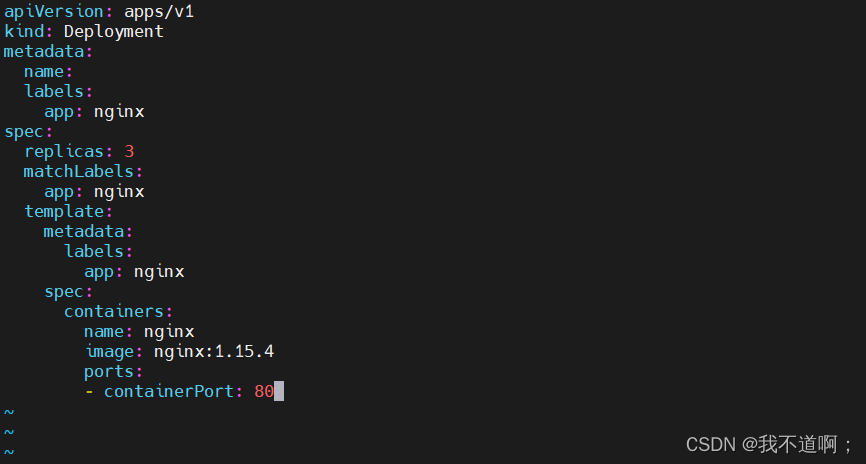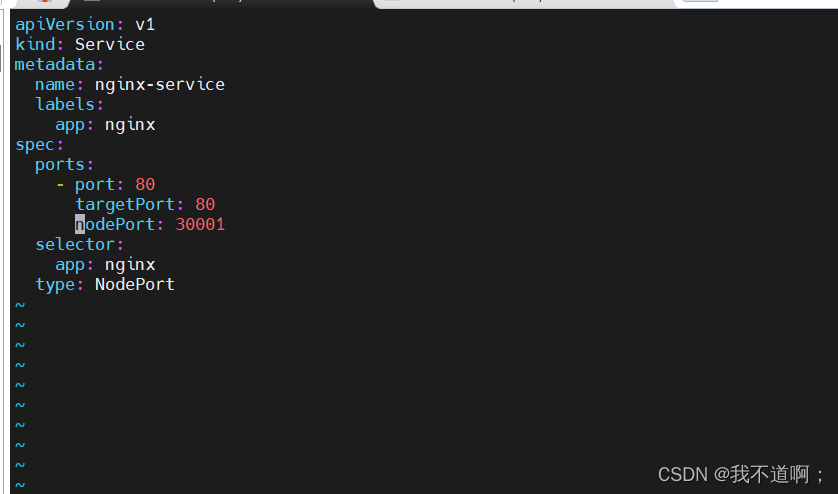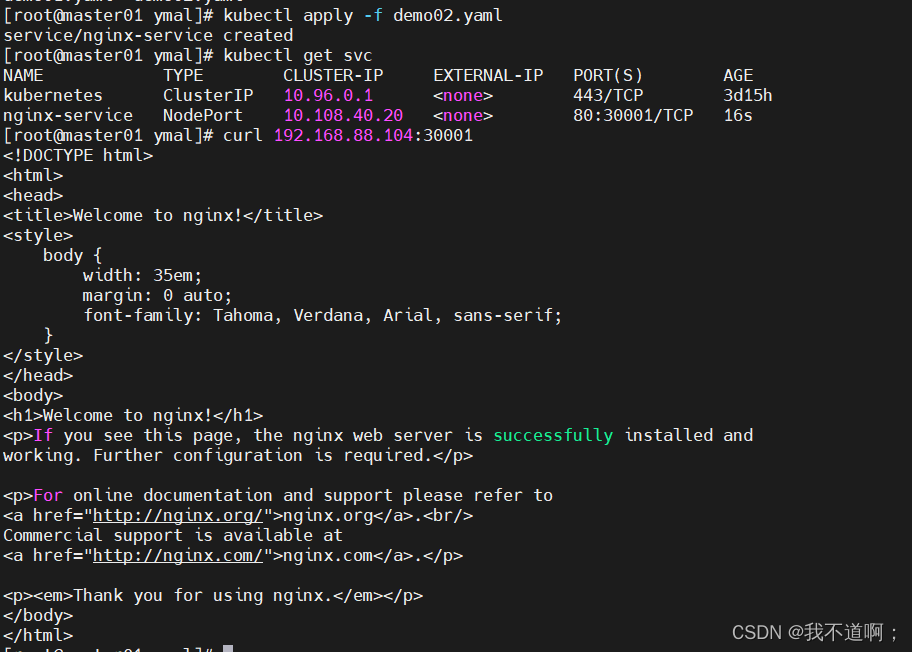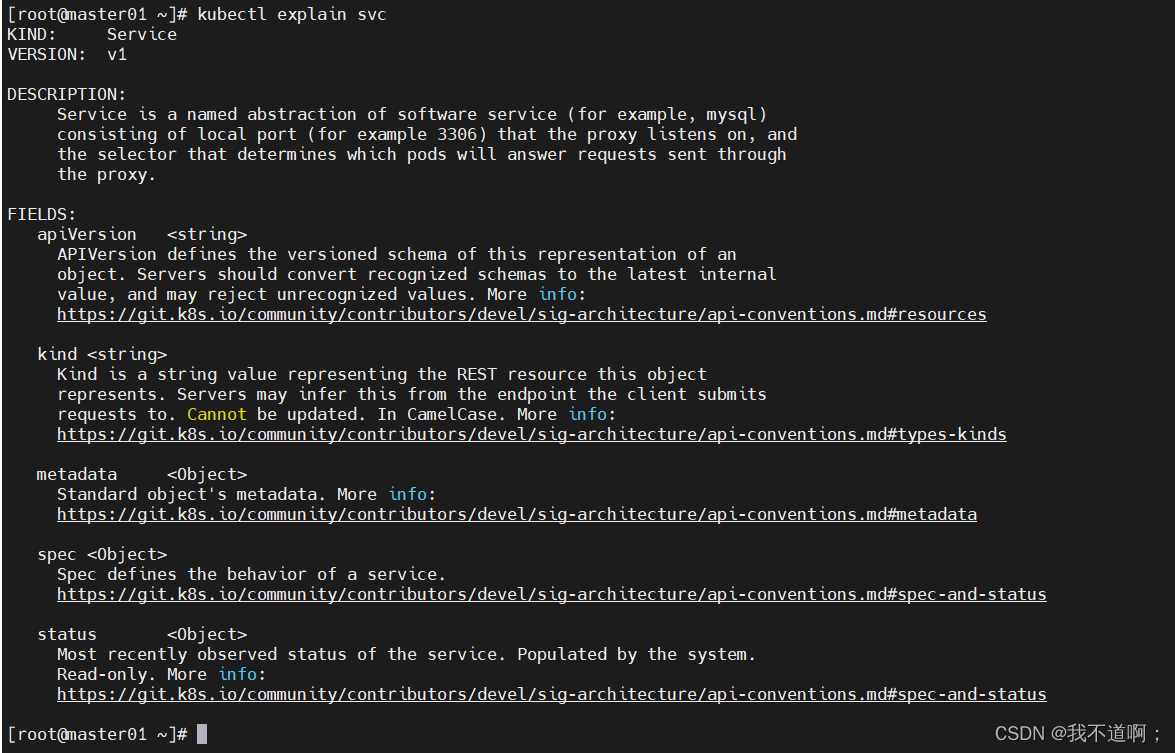-
kubectl声明式资源管理命令
目录
1. 编写创建nginx-deployment,pod文件:
4.4 根据 kubectl explain 命令获取字段信息
一、声明式资源管理介绍:
- 适合于对资源的修改操作
- 声明式资源管理方法依赖于资源配置清单文件对资源进行管理
- 资源配置清单文件有两种格式:yaml(人性化,易读),json(易于api接口解析)
- 对资源的管理,是通过事先定义在统一资源配置清单内,再通过陈述式命令应用到k8s集群里
二、声明式相关命令:
1. 语法格式:
kubectl create/apply/delete -f xxxx.yaml2. 查看资源配置清单:
kubectl get deployment nginx -o yaml3. 解释资源配置清单:
kubectl explain deployment.metadata4. 修改资源配置清单并应用:
4.1 离线修改:
- 修改yaml文件,并用
- kubectl apply -f xxxx.yaml 文件使之生效
- 注意:当apply不生效时,先使用delete清除资源,再apply创建资源
- kubectl get service nginx -o yaml > nginx-svc.yaml
- vim nginx-svc.yaml #修改port: 8080
- kubectl delete -f nginx-svc.yaml
- kubectl apply -f nginx-svc.yaml
- kubectl get svc
4.2 在线修改:
- 直接使用 kubectl edit service nginx
- 在线编辑资源配置清单并保存退出即时生效(如port: 888)
- PS:此修改方式不会对yaml文件内容修改
5. 删除资源配置清单:
- 陈述式删除:
- kubectl delete service nginx
- 声明式删除:
- kubectl delete -f nginx-svc.yaml
三、yaml文件详解:
1. deployment.yaml文件详解:
- apiVersion: extensions/v1beta1 #接口版本
- kind: Deployment #接口类型
- metadata:
- name: cango-demo #Deployment名称
- namespace: cango-prd #命名空间
- labels:
- app: cango-demo #标签
- spec:
- replicas: 3
- strategy:
- rollingUpdate: ##由于replicas为3,则整个升级,pod个数在2-4个之间
- maxSurge: 1 #滚动升级时会先启动1个pod
- maxUnavailable: 1 #滚动升级时允许的最大Unavailable的pod个数
- template:
- metadata:
- labels:
- app: cango-demo #模板名称必填
- sepc: #定义容器模板,该模板可以包含多个容器
- containers:
- - name: cango-demo #镜像名称
- image: swr.cn-east-2.myhuaweicloud.com/cango-prd/cango-demo:0.0.1-SNAPSHOT #镜像地址
- command: [ "/bin/sh","-c","cat /etc/config/path/to/special-key" ] #启动命令
- args: #启动参数
- - '-storage.local.retention=$(STORAGE_RETENTION)'
- - '-storage.local.memory-chunks=$(STORAGE_MEMORY_CHUNKS)'
- - '-config.file=/etc/prometheus/prometheus.yml'
- - '-alertmanager.url=http://alertmanager:9093/alertmanager'
- - '-web.external-url=$(EXTERNAL_URL)'
- #如果command和args均没有写,那么用Docker默认的配置。
- #如果command写了,但args没有写,那么Docker默认的配置会被忽略而且仅仅执行.yaml文件的command(不带任何参数的)。
- #如果command没写,但args写了,那么Docker默认配置的ENTRYPOINT的命令行会被执行,但是调用的参数是.yaml中的args。
- #如果如果command和args都写了,那么Docker默认的配置被忽略,使用.yaml的配置。
- imagePullPolicy: IfNotPresent #如果不存在则拉取
- livenessProbe: #表示container是否处于live状态。如果LivenessProbe失败,LivenessProbe将会通知kubelet对应的container不健康了。随后kubelet将kill掉container,并根据RestarPolicy进行进一步的操作。默认情况下LivenessProbe在第一次检测之前初始化值为Success,如果container没有提供LivenessProbe,则也认为是Success;
- httpGet:
- path: /health #如果没有心跳检测接口就为/
- port: 8080
- scheme: HTTP
- initialDelaySeconds: 60 ##启动后延时多久开始运行检测
- timeoutSeconds: 5
- successThreshold: 1
- failureThreshold: 5
- readinessProbe:
- httpGet:
- path: /health #如果没有心跳检测接口就为/
- port: 8080
- scheme: HTTP
- initialDelaySeconds: 30 ##启动后延时多久开始运行检测
- timeoutSeconds: 5
- successThreshold: 1
- failureThreshold: 5
- resources: ##CPU内存限制
- requests:
- cpu: 2
- memory: 2048Mi
- limits:
- cpu: 2
- memory: 2048Mi
- env: ##通过环境变量的方式,直接传递pod=自定义Linux OS环境变量
- - name: LOCAL_KEY #本地Key
- value: value
- - name: CONFIG_MAP_KEY #局策略可使用configMap的配置Key,
- valueFrom:
- configMapKeyRef:
- name: special-config #configmap中找到name为special-config
- key: special.type #找到name为special-config里data下的key
- ports:
- - name: http
- containerPort: 8080 #对service暴露端口
- volumeMounts: #挂载volumes中定义的磁盘
- - name: log-cache
- mount: /tmp/log
- - name: sdb #普通用法,该卷跟随容器销毁,挂载一个目录
- mountPath: /data/media
- - name: nfs-client-root #直接挂载硬盘方法,如挂载下面的nfs目录到/mnt/nfs
- mountPath: /mnt/nfs
- - name: example-volume-config #高级用法第1种,将ConfigMap的log-script,backup-script分别挂载到/etc/config目录下的一个相对路径path/to/...下,如果存在同名文件,直接覆盖。
- mountPath: /etc/config
- - name: rbd-pvc #高级用法第2中,挂载PVC(PresistentVolumeClaim)
- #使用volume将ConfigMap作为文件或目录直接挂载,其中每一个key-value键值对都会生成一个文件,key为文件名,value为内容,
- volumes: # 定义磁盘给上面volumeMounts挂载
- - name: log-cache
- emptyDir: {}
- - name: sdb #挂载宿主机上面的目录
- hostPath:
- path: /any/path/it/will/be/replaced
- - name: example-volume-config # 供ConfigMap文件内容到指定路径使用
- configMap:
- name: example-volume-config #ConfigMap中名称
- items:
- - key: log-script #ConfigMap中的Key
- path: path/to/log-script #指定目录下的一个相对路径path/to/log-script
- - key: backup-script #ConfigMap中的Key
- path: path/to/backup-script #指定目录下的一个相对路径path/to/backup-script
- - name: nfs-client-root #供挂载NFS存储类型
- nfs:
- server: 10.42.0.55 #NFS服务器地址
- path: /opt/public #showmount -e 看一下路径
- - name: rbd-pvc #挂载PVC磁盘
- persistentVolumeClaim:
- claimName: rbd-pvc1 #挂载已经申请的pvc磁盘
2. Pod yaml文件详解:
- apiVersion: v1 #必选,版本号,例如v1
- kind: Pod #必选,Pod
- metadata: #必选,元数据
- name: string #必选,Pod名称
- namespace: string #必选,Pod所属的命名空间
- labels: #自定义标签
- - name: string #自定义标签名字
- annotations: #自定义注释列表
- - name: string
- spec: #必选,Pod中容器的详细定义
- containers: #必选,Pod中容器列表
- - name: string #必选,容器名称
- image: string #必选,容器的镜像名称
- imagePullPolicy: [Always | Never | IfNotPresent] #获取镜像的策略:Alawys表示总是下载镜像,IfnotPresent表示优先使用本地镜像,否则下载镜像,Nerver表示仅使用本地镜像
- command: [string] #容器的启动命令列表,如不指定,使用打包时使用的启动命令
- args: [string] #容器的启动命令参数列表
- workingDir: string #容器的工作目录
- volumeMounts: #挂载到容器内部的存储卷配置
- - name: string #引用pod定义的共享存储卷的名称,需用volumes[]部分定义的的卷名
- mountPath: string #存储卷在容器内mount的绝对路径,应少于512字符
- readOnly: boolean #是否为只读模式
- ports: #需要暴露的端口库号列表
- - name: string #端口号名称
- containerPort: int #容器需要监听的端口号
- hostPort: int #容器所在主机需要监听的端口号,默认与Container相同
- protocol: string #端口协议,支持TCP和UDP,默认TCP
- env: #容器运行前需设置的环境变量列表
- - name: string #环境变量名称
- value: string #环境变量的值
- resources: #资源限制和请求的设置
- limits: #资源限制的设置
- cpu: string #Cpu的限制,单位为core数,将用于docker run --cpu-shares参数
- memory: string #内存限制,单位可以为Mib/Gib,将用于docker run --memory参数
- requests: #资源请求的设置
- cpu: string #Cpu请求,容器启动的初始可用数量
- memory: string #内存清楚,容器启动的初始可用数量
- livenessProbe: #对Pod内个容器健康检查的设置,当探测无响应几次后将自动重启该容器,检查方法有exec、httpGet和tcpSocket,对一个容器只需设置其中一种方法即可
- exec: #对Pod容器内检查方式设置为exec方式
- command: [string] #exec方式需要制定的命令或脚本
- httpGet: #对Pod内个容器健康检查方法设置为HttpGet,需要制定Path、port
- path: string
- port: number
- host: string
- scheme: string
- HttpHeaders:
- - name: string
- value: string
- tcpSocket: #对Pod内个容器健康检查方式设置为tcpSocket方式
- port: number
- initialDelaySeconds: 0 #容器启动完成后首次探测的时间,单位为秒
- timeoutSeconds: 0 #对容器健康检查探测等待响应的超时时间,单位秒,默认1秒
- periodSeconds: 0 #对容器监控检查的定期探测时间设置,单位秒,默认10秒一次
- successThreshold: 0
- failureThreshold: 0
- securityContext:
- privileged:false
- restartPolicy: [Always | Never | OnFailure] #Pod的重启策略,Always表示一旦不管以何种方式终止运行,kubelet都将重启,OnFailure表示只有Pod以非0退出码退出才重启,Nerver表示不再重启该Pod
- nodeSelector: obeject #设置NodeSelector表示将该Pod调度到包含这个label的node上,以key:value的格式指定
- imagePullSecrets: #Pull镜像时使用的secret名称,以key:secretkey格式指定
- - name: string
- hostNetwork:false #是否使用主机网络模式,默认为false,如果设置为true,表示使用宿主机网络
- volumes: #在该pod上定义共享存储卷列表
- - name: string #共享存储卷名称 (volumes类型有很多种)
- emptyDir: {} #类型为emtyDir的存储卷,与Pod同生命周期的一个临时目录。为空值
- hostPath: string #类型为hostPath的存储卷,表示挂载Pod所在宿主机的目录
- path: string #Pod所在宿主机的目录,将被用于同期中mount的目录
- secret: #类型为secret的存储卷,挂载集群与定义的secre对象到容器内部
- scretname: string
- items:
- - key: string
- path: string
- configMap: #类型为configMap的存储卷,挂载预定义的configMap对象到容器内部
- name: string
- items:
- - key: string
3. Service yaml文件详解:
- apiVersion: v1
- kind: Service
- matadata: #元数据
- name: string #service的名称
- namespace: string #命名空间
- labels: #自定义标签属性列表
- - name: string
- annotations: #自定义注解属性列表
- - name: string
- spec: #详细描述
- selector: [] #label selector配置,将选择具有label标签的Pod作为管理
- #范围
- type: string #service的类型,指定service的访问方式,默认为
- #clusterIp
- clusterIP: string #虚拟服务地址
- sessionAffinity: string #是否支持session
- ports: #service需要暴露的端口列表
- - name: string #端口名称
- protocol: string #端口协议,支持TCP和UDP,默认TCP
- port: int #服务监听的端口号
- targetPort: int #需要转发到后端Pod的端口号
- nodePort: int #当type = NodePort时,指定映射到物理机的端口号
- status: #当spce.type=LoadBalancer时,设置外部负载均衡器的地址
- loadBalancer: #外部负载均衡器
- ingress: #外部负载均衡器
- ip: string #外部负载均衡器的Ip地址值
- hostname: string #外部负载均衡器的主机名
四、yaml文件示例:
1. 编写创建nginx-deployment,pod文件:
- vim nginx-deployment.yaml
- apiVersion: apps/v1 #指定api版本标签
- kind: Deployment #定义资源的类型/角色,deployment为副本控制器,此处资源类型可以是Deployment、Job、Ingress、Service等
- metadata: #定义资源的元数据信息,比如资源的名称、namespace、标签等信息
- name: nginx-deployment #定义资源的名称,在同一个namespace空间中必须是唯一的
- labels: #定义Deployment资源标签
- app: nginx
- spec: #定义deployment资源需要的参数属性,诸如是否在容器失败时重新启动容器的属性
- replicas: 3 #定义副本数量
- selector: #定义标签选择器
- matchLabels: #定义匹配标签
- app: nginx #需与 .spec.template.metadata.labels 定义的标签保持一致
- template: #定义业务模板,如果有多个副本,所有副本的属性会按照模板的相关配置进行匹配
- metadata:
- labels: #定义Pod副本将使用的标签,需与 .spec.selector.matchLabels 定义的标签保持一致
- app: nginx
- spec:
- containers: #定义容器属性
- - name: nginx #定义一个容器名,一个 - name: 定义一个容器
- image: nginx:1.15.4 #定义容器使用的镜像以及版本
- ports:
- - containerPort: 80 #定义容器的对外的端口
- //创建资源对象
- kubectl create -f nginx-deployment.yaml
- //查看创建的pod资源
- kubectl get pods -o wide


2. 创建service服务:
- apiVersion: v1
- kind: Service
- metadata:
- name: nginx-service
- labels:
- app: nginx
- spec:
- ports:
- - port: 80
- targetPort: 80
- nodePort: 30001 #指定NodePort模式node节点开启的端口(30000~32767)
- selector:
- app: nginx #标签选择为nginx
- type: NodePort
- //创建资源对象
- kubectl apply -f nginx-service.yaml
- //查看创建的service
- kubectl get svc


五、详解k8s中的port:
1. port:
port 是 k8s 集群内部访问service的端口,即通过 clusterIP: port 可以从 Pod 所在的 Node 上访问到 service
2. nodePort:
nodePort 是外部访问 k8s 集群中 service 的端口,通过 nodeIP: nodePort 可以从外部访问到某个 service。
3. targetPort:
targetPort 是 Pod 的端口,从 port 或 nodePort 来的流量经过 kube-proxy 反向代理负载均衡转发到后端 Pod 的 targetPort 上,最后进入容器。
4. containerPort:
containerPort 是 Pod 内部容器的端口,targetPort 映射到 containerPort。
六、试运行与文件模板:
1. --dry-run=client试运行:
- kubectl run nginx-test --image=nginx --port=80 --dry-run=client
- kubectl create deployment nginx-deploy --image=nginx --port=80 --replicas=3 --dry-run=client
2. 查看生成yaml格式:
- kubectl run nginx-test --image=nginx --port=80 --dry-run=client -o yaml
- kubectl create deployment nginx-deploy --image=nginx --port=80 --replicas=3 --dry-run=client -o yaml
3. 查看生成json格式:
- kubectl run nginx-test --image=nginx --port=80 --dry-run=client -o json
- kubectl create deployment nginx-deploy --image=nginx --port=80 --replicas=3 --dry-run=client -o json
4. 获取资源配置清单文件模板:
4.1 . 查看已存在的资源配置的方式:
- kubectl get svc nginx-service -o yaml > my-svc.yaml
- 或
- kubectl edit svc nginx-service #复制配置,再粘贴到新文件
4.2 --dry-run=client 导出生成模板:
- //使用yaml格式导出生成模板,并进行修改以及删除一些不必要的参数
- kubectl run nginx-test --image=nginx --port=80 --dry-run=client -o yaml > nginx-test.yaml
- kubectl create deployment nginx-deploy --image=nginx --port=80 --replicas=3 --dry-run=client -o yaml > nginx-deploy.yaml
4.3 复制K8S官方文档的资源配置案例
4.4 根据 kubectl explain 命令获取字段信息
kubectl explain svc
-
相关阅读:
卷积神经网络
R语言对用电负荷时间序列数据进行K-medoids聚类建模和GAM回归
哆啦a梦教你页面的转发与重定向
【Spring Cloud】Docker的基本操作
D2. Dances (Hard Version) Codeforces Round 905 (Div. 2)
在Docker容器中配置`code-server`以访问宿主机的Docker环境
【使用Cpolar和Qchan搭建自己的个人图床】
汇编基础(2) -- ARM64
蚂蚁 2025届暑期实习 多模态LLM 面经
mybatis-plus 动态表名简易使用
- 原文地址:https://blog.csdn.net/2301_78106979/article/details/134300754
